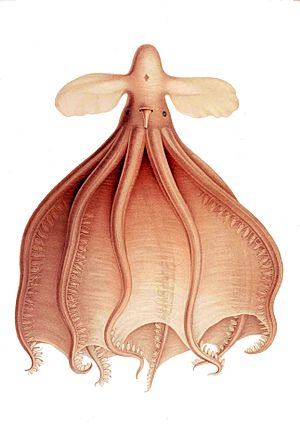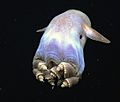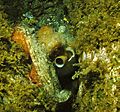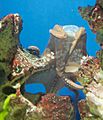Octopoda facts for kids
Quick facts for kids OctopodaTemporal range: 323 mya Upper Carboniferous – present
|
|
|---|---|
 |
|
| The common octopus, Octopus vulgaris. | |
| Scientific classification | |
| Kingdom: | |
| Phylum: | |
| Class: | |
| Subclass: | |
| Superorder: | |
| Order: |
Octopoda
|
| Suborders | |
Octopods are an amazing group of sea animals. They belong to the same family as squids and cuttlefish. You might know them best as octopuses! These creatures have eight arms and are known for being super smart.
Scientists don't find many octopod fossils. But we know they have been around for a very long time. Their history goes back to the late Carboniferous period, about 323 million years ago.
Contents
Different Kinds of Octopods
Octopods are divided into two main groups, called suborders. Each group has its own special features.
Incirrina: The Common Octopuses
The first group is called Incirrina (say: In-sir-REE-na). This group includes the octopuses you often see. They live in rocky areas along the coast and in colorful coral reefs. These octopuses are famous for their flexible arms. They use their arms to explore, hunt, and even squeeze into tiny spaces.
Cirrina: The Finned Octopods
The second group is called Cirrina (say: Sir-REE-na). These octopods are quite different. Their arms are connected by a special umbrella-like web. This web helps them move in a unique way. Many Cirrina octopods live in the deep sea. They often have fins on their heads, which help them swim.
Super Smart Octopuses
Octopuses are known for being very intelligent. They can solve puzzles and even use tools. For example, some octopuses can open jars with screw caps. Others use coconut shells as shelters. This shows how clever they are! They learn quickly by watching others.
How Octopuses Move and Hunt
Octopuses move in a few different ways. They can crawl along the seafloor using their arms. They can also swim by pushing water out of a special tube called a siphon. This jet propulsion helps them move quickly. When hunting, they use their strong suckers to grab prey. They eat crabs, fish, and other small sea creatures.
Octopus Defenses
Octopuses have amazing ways to protect themselves. They are masters of camouflage. They can change their skin color and texture in seconds. This helps them blend in perfectly with their surroundings. If a predator gets too close, an octopus can squirt a cloud of dark ink. This ink confuses the attacker and gives the octopus time to escape. Some octopuses, like the blue-ringed octopus, have bright warning colors. These colors tell predators that they are venomous.
Octopus Life Cycle
Most octopuses have a relatively short life. Some live only for about a year. Others, like the giant Pacific octopus, can live for several years. Female octopuses lay thousands of eggs. They guard their eggs carefully until they hatch. After the eggs hatch, the tiny baby octopuses, called paralarvae, float in the ocean as plankton. They grow quickly into adult octopuses.
Where Do Octopods Live?
Octopods live in all the world's oceans. You can find them in warm tropical waters and in the cold depths of the polar seas. They live in various habitats, from shallow coral reefs to the deepest parts of the ocean.
Octopods in History and Culture
Octopuses have fascinated humans for thousands of years. Ancient civilizations, like the Minoans, created beautiful art featuring octopuses. Sailors often told stories of giant sea monsters, like the Kraken, which were inspired by large cephalopods. Today, octopuses continue to inspire scientists and engineers. Their flexible arms have even inspired new types of robots!
Related Pages
Images for kids
-
A giant Pacific octopus at Echizen Matsushima Aquarium, Japan
-
Diagram of octopus from side, with gills, funnel, eye, ocellus (eyespot), web, arms, suckers, hectocotylus and ligula labelled.
-
Eye of common octopus
-
Octopus paralarva, a planktonic hatchling
-
Veined octopus eating a crab
-
Movements of the finned species Cirroteuthis muelleri
-
Warning display of greater blue-ringed octopus (Hapalochlaena lunulata)
-
The octopuses evolved from the Muensterelloidea (fossil pictured) in the Jurassic period.
-
Minoan clay vase with octopus decoration, c. 1500 BC
-
Pen and wash drawing of an imagined colossal octopus attacking a ship, by the malacologist Pierre de Montfort, 1801
-
Flexible biomimetic 'Octopus' robotics arm. The BioRobotics Institute, Scuola Superiore Sant'Anna, Pisa, 2011
See also
 In Spanish: Pulpos para niños
In Spanish: Pulpos para niños

















